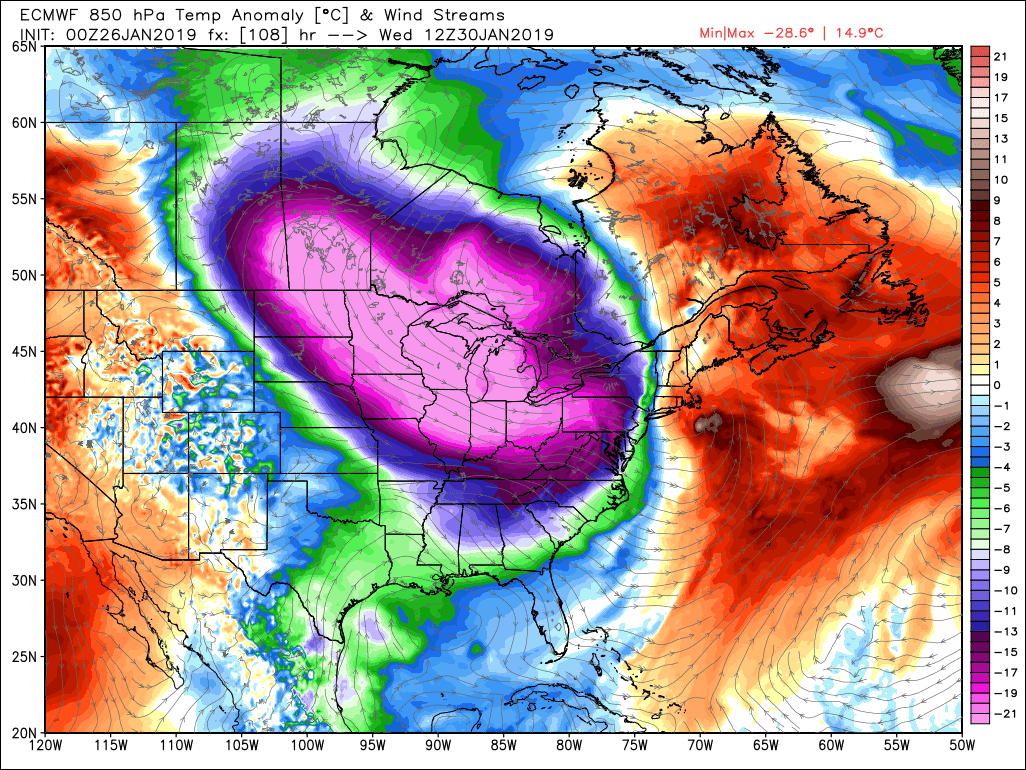
Another Polar Vortex is descending upon the United States, and it’s expected to bring record cold to the Midwest and Mid-Atlantic. The news media will be full of human-interest stories about new temperature records, homeless people freezing, and disruptions to daily life and business. But the real action will be how the energy industry — electric utilities, natural gas pipelines, home oil deliveries — hold up under the strain. If the system holds together, the harm to human health will be limited. If pieces of the system fail, hundreds or thousands of people could die from the cold.
Judging from the map above, based on the forecast of a European weather model that’s now a few days old, Virginia will be on the edge of the vortex. But we’re part of the PJM Interconnection system, whose territory will be smack dab in the middle of the weather system. Also, bitter cold will strain the capacity of natural gas pipelines to deliver gas used for home heating.
As legislators ponder Virginia’s energy future, debating the proper mix of solar, wind, coal, nuclear, natural gas, and electric transmission capacity, this is exactly the kind of extreme-weather event we need to prepare for. We can build an electric grid and gas-pipeline system that can perform beautifully 360 days of the year, but if it isn’t robust enough to handle a polar vortex, hurricane or other infrequent but recurring stressor, the result could be catastrophic.
Some bell weathers to watch:
- Solar and wind. What happens to solar and onshore wind production during the polar vortex? We know that wind and solar isn’t dispatchable — that is, we can’t turn it on and off when we need it — but can renewable sources at least maintain their share of electricity production? Does renewable production tend to decline during polar vortex-like events — less sun, less wind — adding to the strain on other energy sources?
- Natural gas (home heating). Natural gas is the big swing fuel that can dial up and down rapidly in response to changes in demand. Natural gas consumption, used for home heating, soars during deep freezes. Can the system of natural gas pipelines accommodate the surge? Are curtailable industries forced to stop using gas? Worst case scenario, are supplies sufficient to keep peoples’ homes heated?
- Natural gas (electric generation). If gas supplies are constrained, do electric utilities get enough gas to power their gas-fired generators? If not, to what extent are utilities forced to bring aging oil-fired units out of mothballs and crank them up?
- Nuclear. Is it possible to dial up generation of nuclear units?
- Reserve margin. Most sources I’ve read seem confident that our energy system can handle a Polar Vortex event just fine — this year at least. The question is how much margin is there for error, and what the portends for the future as utilities phase out aging coal- and nuclear-powered units.
Hopefully, Virginia will sail through this event with minimal trauma. But all parties involved — legislators, regulators, utilities, the general public, news media — should be paying close attention to how our energy infrastructure holds up under the strain. The knowledge we gain will inform our push into an energy future dominated by solar and wind.

Leave a Reply
You must be logged in to post a comment.